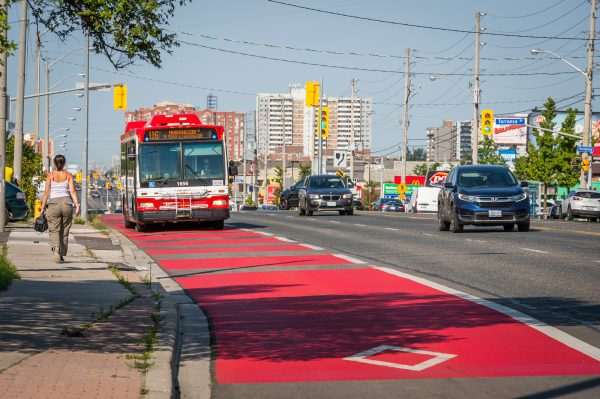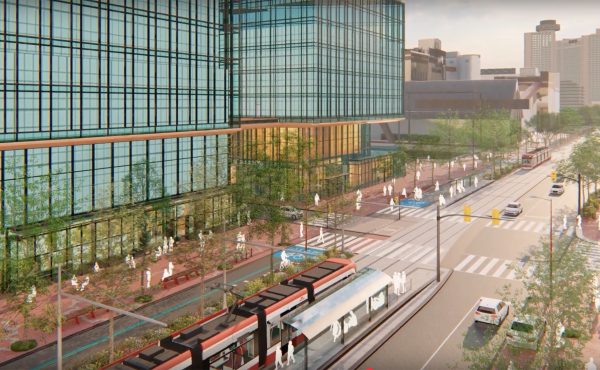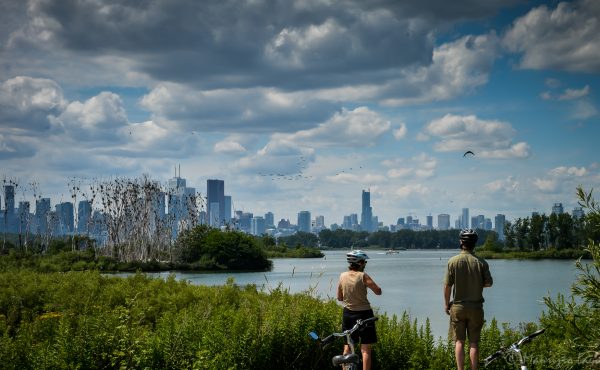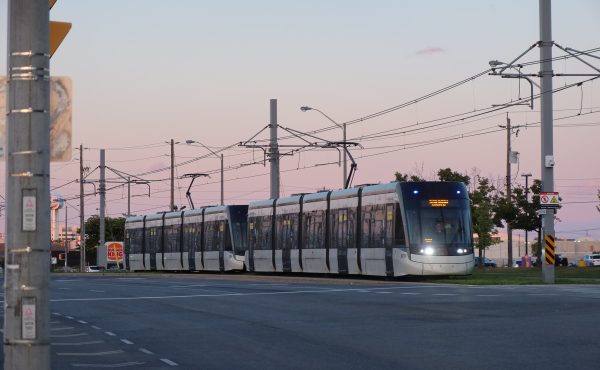There’s a glaring irony about the city’s messily disintegrating priority bus lane plan, which landed at executive committee yesterday accompanied by a half-hearted compromise. Not only is this scheme branded RapidTO (ah, memories of the John Tory’s reign of error), but it traces all the way back to a 2018 TTC/Transportation Services “surface transit” strategy — an interval that now feels far more tortoise than hare. But we know Toronto council is an irony-free zone, and its denizens rarely feel compelled to apply consistency to their (in)decision-making, much less a sense of urgency.
The latest plot twist has been well publicized, but the fight over the much abused Bathurst priority lane proposal is really about competing inconveniences (offered here in ascending order): those of the entitled merchants south of Dupont; those of the folks who believe that street-parking is a god-given right; those of the people who insist on driving in and out of the core at rush hour; and those of the 35,000 commuters a day who sit on Bathurst’s traffic-stranded buses (as well as the streetcars south of Bloor) because they don’t have options to get to the large employment hubs on the west side of the downtown.
The shoutiest group on this list is also the smallest, but they have the ear of the local councillor, Dianne Saxe (who has caved spectacularly), an overly credulous media, and the political organizers who recognize a wedge issue with all the fixings when they see one. (In a self-serving LinkedIn post this week, Saxe, a self-styled transit and cycling advocate, defended her flip-flop by arguing that it’s not the right moment to poke the bear in Queen’s Park.)
I’d like to focus in for a moment on the seven-year period that has passed since the idea of a surface transit priority network first, well, surfaced. In 2018, with the pandemic still just a virus hiding on a duck in Wuhan, the TTC was working at peak capacity. Vehicles and platforms were jammed, and its popularity reflected a city with high employment, a vibrant core, and predictable travel patterns.
A bit of time passed, and the branded version, now known as RapidTO, re-surfaced in mid-to-late 2020, a time when many people were working from home and traffic was way down in most parts of the city, but not all. The subways were empty yet many suburban bus trunk routes were still carrying thousands of essential workers.
Council unanimously passed a report laying out the surface transit plan, but here, instead of carpe diem-style action, is where the downshifting began. Engineering studies were ordered up. Processes were put in place. Notices were circulated.
It took a full year for council to land on a “consultation plan,” which was to include meetings with individual councillors, as well as all manner of stakeholders. However, Eglinton East quickly got its two red painted lanes — progress! But then the whole effort disappeared into the maw of the city’s bureaucracy for over two years, re-re-surfacing again in early 2024 as a bewilderingly complex ten-year plan that council could adopt “in principle.”
The weasel words were right there in the first paragraph of the staff recommendations, signalling all and sundry to begin their various rearguard actions, all of which have spent the last 16 months ripening into what we’re seeing today: a slow-motion car accident.
There’s more than mere analysis-paralysis going on here, although plenty of that as well. The city, it cannot be said loudly enough, blithely missed the moment, which occurred about three years ago, when gridlock had yet to congeal into what exists now.
It’s also important to say that we didn’t miss the moment entirely: the city made significant additions to its bike lane network during the pandemic, taking advantage of relatively open roads and also the leadership shown by other big cities (Paris, Montreal, New York) seeking to retrofit their street grids to reflect a profound paradigm shift in urban travel.
There’s an even more salient example of made-in-Toronto policy reform management, but to find it we need to mosey on over to the planning department. In roughly the same period, city planners created and then won approval for a series of zoning reforms that open up huge swaths of the city’s sacrosanct residential areas to gentle intensification in the form of as-of-right laneway and garden suites, triplexes, fourplexes, and other moves lumped in with the Expanding Housing Options Now (EHON) agenda.
For a city so conservative about its house neighbourhoods, these reforms, which were as technically involved as any bus lane engineering study, qualify as genuinely radical. But it’s the way they were conceived and then presented to council that bears noting here. Instead of trying to construct a set of fool-proof policies, which have been pre-vetted to the nines, the planning department adopted a Silicon Valley MO: put something imperfect out there, monitor how the city and the market respond, then course correct as necessary.
The significance of this approach can’t be over-stated: the city bureaucracy and council got their heads together and achieved a difficult but important thing within a finite time-frame. The result isn’t perfect, as the recent six-plex fiasco demonstrated. Yet far-reaching zoning and land-use reforms have taken hold in less time than we’ve been arguing about the kinds of prioritized bus lanes that have become table stakes in cities around the world.
Another damning comparison: the St. Clair West streetcar right-of-way was under-sold, fought over, approved, re-litigated and constructed in just six years (2004-2010). In a city buckling under the weight of numbing gridlock, we must be able to do better than that with a surface transit network which is the actual lifeblood of the TTC.
Laying blame is a bit of a mug’s game. In Toronto, after all, success is the orphan while failure has many parents. I fully expect more orchestrated challenges to Not-So-RapidTO; after all, a template for successfully fighting these projects is now out there for all to use, and so perhaps the near-term fate of this strategy is that the squirrels will nibble it to death.
Mayor Olivia Chow’s face-saving compromise — approved yesterday, directing staff to study (!) how to get the Bathurst and Dufferin lanes operational by 2026 in time for our FIFA World Cup games — is kind of pathetic, to be honest. (Council has yet to sign off.) Surely, we should be making these changes to address the daily needs of tens of thousands of Toronto commuters, not provide out-of-town visitors with a seamless experience that could, of course, be undone after the beautiful game’s pricey circus leaves town.
In the interim, I’d urge the planners at the TTC and transportation services, as well as the mayor’s issues management team, to actually try and learn something profound from what the planning department achieved with EHON between 2019 and 2024, which boils down to the old adage about not allowing the perfect to become the enemy of the good.
In aspiring to engineering perfection, RapidTO became anything but because the city insisted on trying to address absolutely everyone’s issues and instead ended up getting nothing done. The lesson is there for the taking.
Image via TTC





One comment
Thanks John. Great article!